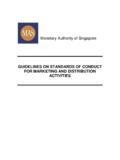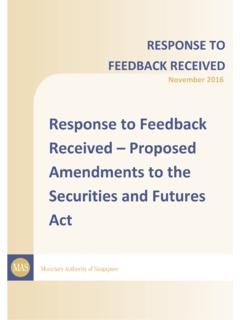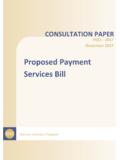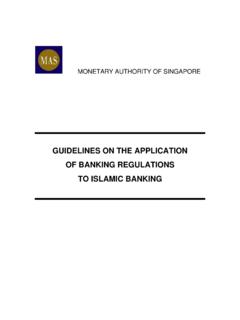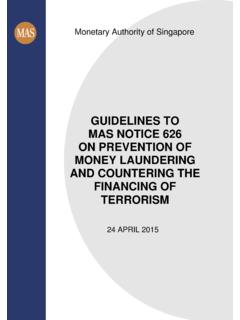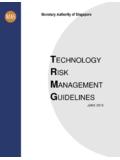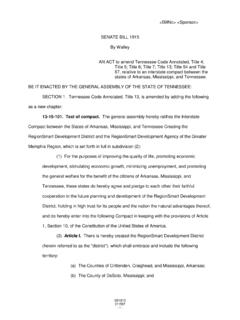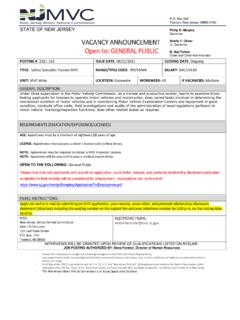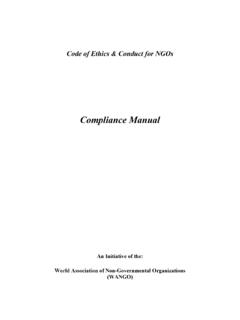Transcription of CODE OF CORPORATE GOVERNANCE 6 AUGUST 2018
1 code OF CORPORATE GOVERNANCE . 6 AUGUST 2018. Introduction 1. CORPORATE GOVERNANCE refers to having the appropriate people, processes and structures to direct and manage the business and affairs of the company to enhance long-term shareholder value, whilst taking into account the interests of other stakeholders. Companies that embrace the tenets of good GOVERNANCE , including accountability, transparency and sustainability, are more likely to engender investor confidence and achieve long-term sustainable business performance.
2 2. The code of CORPORATE GOVERNANCE (the code ), which is applicable to listed companies in Singapore on a comply-or-explain basis, first came into effect on 1. January 2003. The code aims to promote high levels of CORPORATE GOVERNANCE in Singapore by putting forth Principles of good CORPORATE GOVERNANCE and Provisions with which companies are expected to comply. The Practice Guidance complements the code by providing guidance on the application of the Principles and Provisions and setting out best practices for companies.
3 adoption of the Practice Guidance is voluntary. 3. The code takes as its starting point a recognition that the Board has the dual role of setting strategic direction, and of setting the company's approach to GOVERNANCE . This includes establishing an appropriate culture, values and ethical standards of conduct at all levels of the company. The role of the Board is therefore broader than that of providing oversight. A well-constituted Board fosters more complete discussions, leading to better decisions and enhanced business performance.
4 This version of the code expands on the need for a strong and independent element on the Board, along with a diverse skill set. 4. Given the centrality of the Board to good CORPORATE GOVERNANCE , it is fundamental that the Chairman of the Board (the Chairman ) sets the right tone. The Chairman should encourage a full and frank exchange of views, drawing out contributions from all directors so that the debate benefits from the full diversity of views around the boardroom table. The Chairman should seek to stimulate and engender a robust yet collegiate setting, set the right ethical and behavioural tone, and provide leadership to the Board.
5 5. Good CORPORATE GOVERNANCE is good for the company, with a well-governed company better placed to perform over the longer-term. The code should not be seen as burdensome but should help companies by giving clear direction on good Board and Management practices that will help build investor and stakeholder confidence. For this outcome, a culture of substantive compliance, rather than a checklist approach, is crucial. A sustainably successful company is good for myriad stakeholders: employees, suppliers, customers, shareholders, as well as society at large.
6 Comply or explain 6. This updated version of the code represents a significant development both in terms of the way the code is structured, and the way in which companies are required to describe their CORPORATE GOVERNANCE practices. 7. This version of the code has at its core broad Principles of CORPORATE GOVERNANCE . Compliance with, and observation of, these Principles is mandatory. These Principles set out broadly accepted characteristics of good CORPORATE GOVERNANCE . Companies are required 1 to describe their CORPORATE GOVERNANCE practices with reference to both the Principles and Provisions, and how the company's practices conform to the Principles.
7 8. The Provisions that underpin the Principles are designed to support compliance with the Principles. These Provisions, which replace the Guidelines of previous Codes, are drafted in a simple and direct manner, and describe the tenets of good CORPORATE GOVERNANCE . Companies are expected to comply with the Provisions, and variations from Provisions are acceptable to the extent that companies explicitly state and explain how their practices are consistent with the aim and philosophy of the Principle in question.
8 The explanations of variations should be comprehensive and meaningful. 9. The emphasis of the code is for companies to provide thoughtful and meaningful explanations around their practices, and for investors to carefully consider these discussions as part of their engagements with companies. Frank and informed dialogue between companies and their shareholders is a central tenet of good CORPORATE GOVERNANCE , and encourages more active stewardship. Better engagement between these parties will benefit the company and investors.
9 1 Rule 710 of the SGX Listing Rules (Mainboard) / Rule 710 of the SGX Listing Rules (Catalist). BOARD MATTERS. THE BOARD'S CONDUCT OF AFFAIRS. Principle: 1 The company is headed by an effective Board which is collectively responsible and works with Management for the long-term success of the company. Provisions: Directors are fiduciaries who act objectively in the best interests of the company and hold Management accountable for performance. The Board puts in place a code of conduct and ethics, sets appropriate tone-from-the-top and desired organisational culture, and ensures proper accountability within the company.
10 Directors facing conflicts of interest recuse themselves from discussions and decisions involving the issues of conflict. Directors understand the company's business as well as their directorship duties (including their roles as executive, non-executive and independent directors). Directors are provided with opportunities to develop and maintain their skills and knowledge at the company's expense 2. The induction, training and development provided to new and existing directors are disclosed in the company's annual report.
